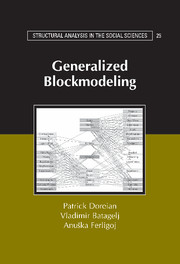Book contents
- Frontmatter
- Contents
- Preface
- 1 Social Networks and Blockmodels
- 2 Network Data Sets
- 3 Mathematical Prelude
- 4 Relations and Graphs for Network Analysis
- 5 Clustering Approaches
- 6 Optimizational Approach to Conventional Blockmodeling
- 7 Foundations for Generalized Blockmodeling
- 8 Blockmodeling Two-Mode Network Data
- 9 Semirings and Lattices
- 10 Balance Theory and Blockmodeling Signed Networks
- 11 Symmetric–Acyclic Blockmodels
- 12 Extending Generalized Blockmodeling
- Bibliography
- Author Index
- Subject Index
- Titles in the series
2 - Network Data Sets
Published online by Cambridge University Press: 13 January 2010
- Frontmatter
- Contents
- Preface
- 1 Social Networks and Blockmodels
- 2 Network Data Sets
- 3 Mathematical Prelude
- 4 Relations and Graphs for Network Analysis
- 5 Clustering Approaches
- 6 Optimizational Approach to Conventional Blockmodeling
- 7 Foundations for Generalized Blockmodeling
- 8 Blockmodeling Two-Mode Network Data
- 9 Semirings and Lattices
- 10 Balance Theory and Blockmodeling Signed Networks
- 11 Symmetric–Acyclic Blockmodels
- 12 Extending Generalized Blockmodeling
- Bibliography
- Author Index
- Subject Index
- Titles in the series
Summary
Generalized blockmodeling is both an approach to the analysis of network data and an expanding set of data analytic procedures. Data are crucially important. For any substantive problem, it is useful to combine the results of different analyses. This is true also for network analysis, and all analyses have the potential to inform subsequent studies of relevant network data. We mirror this by making repeated use of specific data sets in the chapters that follow. As a result, the interpretation of our analyses cumulates with each use of a specific data set. We use this chapter to provide descriptions of the data sets we use most often. Some of these are classic data sets that have been used repeatedly as test beds for assessing new tools, whereas other data sets we use have seen little utilization beyond their first report.
These data sets have been chosen to represent a variety of network data structures that include the following: (i) a binary relation at one point in time, (ii) a binary relation at multiple points in time, (iii) a valued relation at one point in time, (iv) a valued relation at multiple points in time, (v) multiple binary relations, (vi) multiple valued relations, and (vi) signed graphs. Each data set is accompanied by a description of some earlier analyses of these data. We use a specific capitalized label for each data set, and the first use of each label is enclosed in parentheses. Our focus is on partitioning social actors involved in these networks into clusters and partitioning of the social ties into blocks.
- Type
- Chapter
- Information
- Generalized Blockmodeling , pp. 30 - 63Publisher: Cambridge University PressPrint publication year: 2004

